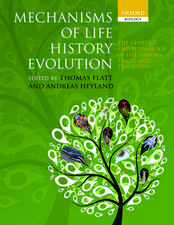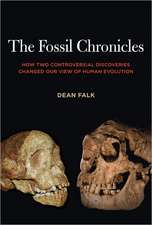The Science of Human Evolution: Getting it Right
Autor John H. Langdonen Limba Engleză Hardback – 15 noi 2016
| Toate formatele și edițiile | Preț | Express |
|---|---|---|
| Paperback (1) | 629.23 lei 6-8 săpt. | |
| Springer International Publishing – 27 iun 2018 | 629.23 lei 6-8 săpt. | |
| Hardback (1) | 587.53 lei 6-8 săpt. | |
| Springer International Publishing – 15 noi 2016 | 587.53 lei 6-8 săpt. |
Preț: 587.53 lei
Preț vechi: 691.20 lei
-15% Nou
Puncte Express: 881
Preț estimativ în valută:
112.43€ • 116.72$ • 93.75£
112.43€ • 116.72$ • 93.75£
Carte tipărită la comandă
Livrare economică 22 martie-05 aprilie
Preluare comenzi: 021 569.72.76
Specificații
ISBN-13: 9783319415840
ISBN-10: 3319415840
Pagini: 189
Ilustrații: XXI, 220 p. 48 illus., 43 illus. in color.
Dimensiuni: 155 x 235 x 19 mm
Greutate: 0.52 kg
Ediția:1st ed. 2016
Editura: Springer International Publishing
Colecția Springer
Locul publicării:Cham, Switzerland
ISBN-10: 3319415840
Pagini: 189
Ilustrații: XXI, 220 p. 48 illus., 43 illus. in color.
Dimensiuni: 155 x 235 x 19 mm
Greutate: 0.52 kg
Ediția:1st ed. 2016
Editura: Springer International Publishing
Colecția Springer
Locul publicării:Cham, Switzerland
Cuprins
Introduction: The Method of Science.- Case Study 1. The Darwinian Paradigm: An Evolving World View.- Case Study 2. Proving Prehistory: William Pengelly and Scientific Excavation.- Case Study 3. Testing Predictions: Eugene Dubois and the Missing Link.- Case Study 4. Self-Correcting Science: The Piltdown Forgery.- Case Study 5. Checking the Time: Geological Dating at Olduvai Gorge.- Case Study 6. Quantifying Evolution: Morris Goodman and Molecular Phylogeny.- Case Study 7. Reinterpreting Ramapithecus: Reconciling Fossils and Molecules.- Case Study 8. Taming the Killer Ape: The Science of Taphonomy.- Case Study 9. Reading the Bones (1): Recognizing Bipedalism.- Case Study 10. Reading the Bones (2): Sizing up the Ancestors.- Case Study 11. The Habilis Workbench: Experimental Archaeology.- Case Study 12. Hunting for Predators: The Scavenging Hypothesis.- Case Study 13. Climate Change in the Pliocene: Environment and Human Origins.- Case Study 14. Free Range Homo: Modernizing the Bodyat Dmanisi.- Case Study 15. Reading the Bones (3): Tracking Life History at Nariokotome.- Case Study 16, Democratizing Homo naledi: A New Model for Fossil Hominin Studies.- Case Study 17. A Curious Isolation: The Hobbits of Flores.- Case Study 18, Neanderthals in the Mirror: Imagining our Relatives.- Case Study 19, Leaving Africa: Mitochondrial Eve.- Case Study 20. The Neanderthal Problem: Neighbors and Relatives on Mt. Carmel.- Case Study 21. Chasing Smaller Game: The Archaeology of Modernity.- Case Study 22, Strangers in Paradigms: Ancient DNA Reveals Mysterious Populations.- Case Study 23, Is Humanity Sustainable? Tracking the Source of our Ecological Uniqueness.- Case Study 24, The Unknowable Biped: Questions We Cannot Answer.- Case Study 25, Parsimony and the Aquatic Ape.- Case Study 26. What Science Is: A Cultural and Legal Challenge.
Recenzii
“This is a very unusual, interesting, and useful book in which the author reviews a series of topics in human evolution that have been, or remain, characterized by alternative views, and how these issues have been addressed, or resolved … . Each chapter ends with a series of questions for discussion and a short bibliography for additional reading. The volume is ideal for a seminar course at either the undergraduate or graduate level.” (John G. Fleagle, The Quarterly Review of Biology, Vol. 92 (4), December, 2017)
“The book will be of greatest value for undergraduates seeking intellectual and chronological continuity among breakthroughs often presented in narrower contexts. Instructors will appreciate the thoughtful discussion questions included at the end of each section. Extensive references ensure that the book will also be of value to more advanced students who seek to read in greater depth on individual topics. Summing Up: Highly recommended. Lower-division undergraduates and above; faculty and general readers.” (D. P. Genereux, Choice, Vol. 54 (10), June, 2017)Notă biografică
John H. Langdon, Ph.D.
Professor of Biology and Anthropology
University of Indianapolis
Current research interests include hominin and hominoid paleontology and evolution, history and development of paleoanthropology, origins of human bipedalism, evolution of human behavior, historical demography, human biology, and history and process of the natural sciences.
Caracteristici
Provides discussion questions for each chapter that encourage students to explore the implications of the material they have read Structured to follow the chronology of human evolution from the Miocene to modern humans, so that they can be studied in sequence during the semester of a typical course Provides historical context of the development of the field for each case







